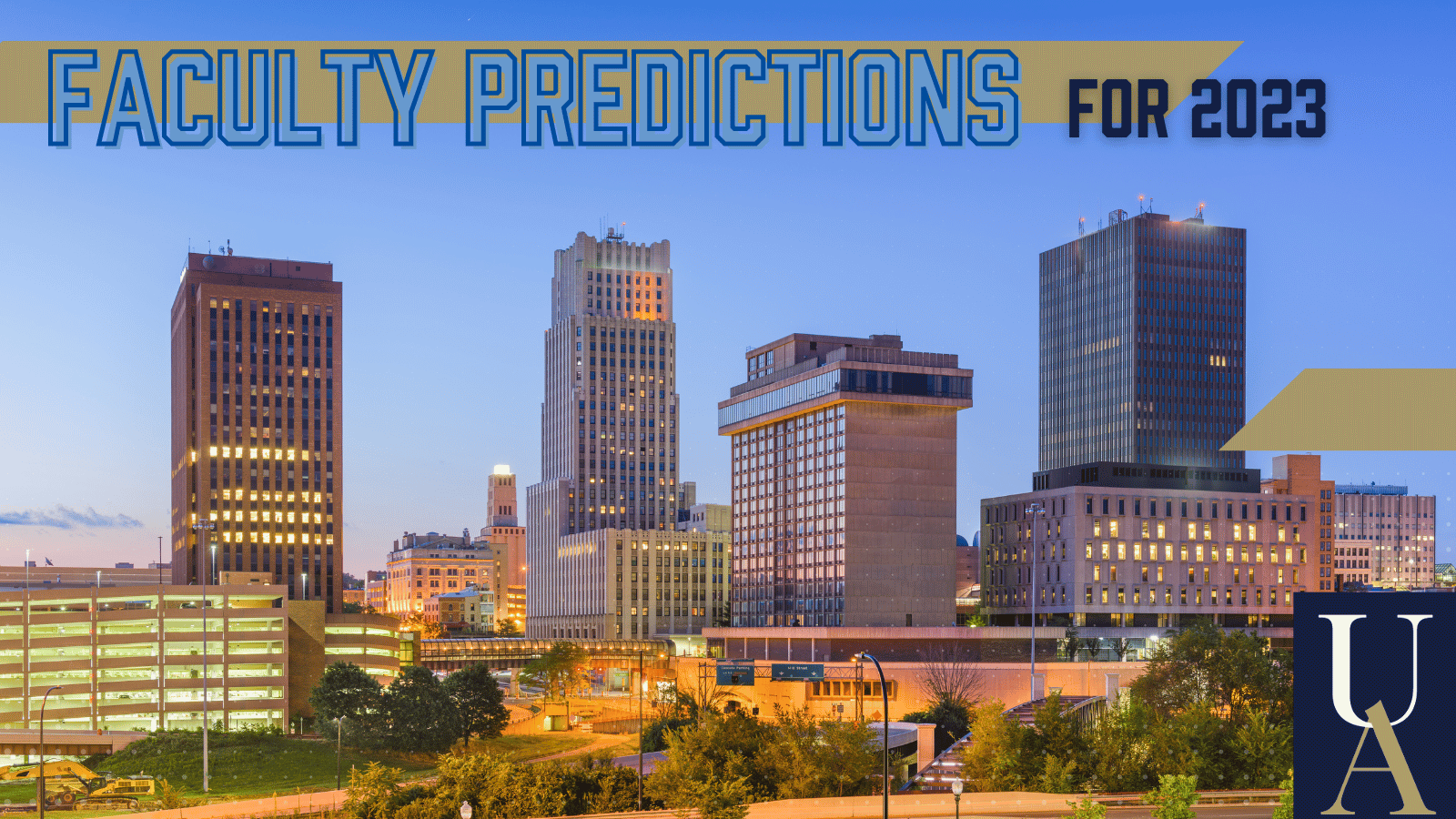
Will the U.S. slide into a recession? Will the protests in Iran finally cause a political transformation there? Will airline prices ever come down?
From politics to mapping oceans to online privacy, 2023 will bring some change, according to members of The University of Akron faculty who made predictions for the coming year in their fields of expertise.
Resoundingly, we will continue to endure unsettlement and uncertainty as we recover from the pandemic, deal with the challenge of climate change and experience political shifts.
However, the biggest changes we could see may be in how these and other issues will be addressed. New approaches to dealing with a shortage of skilled teachers, for example, may help ease this national challenge. Artists are re-thinking how best to connect with consumers, particularly as we continue to see audiences slow to return to entertainment venues following the pandemic. And although it’s unlikely at this time last year that anyone could have predicted Elon Musk would own Twitter, it’s clear that new social media apps will emerge as the traditional outlets struggle.
Below, a selection of UA faculty members offer their predictions for the coming year.
Performing arts
Prediction: Still on the rebound from the pandemic, artists will rethink how technology can bolster connection with consumers
 By Theron Brown, assistant professor of practice, School of Music, Buchtel College of Arts and Sciences
By Theron Brown, assistant professor of practice, School of Music, Buchtel College of Arts and Sciences
The art world has been shaken up and is still in a form of recovery, but I do feel that it’s on a steady incline with a fresh take for the artist and the art consumer. I’m a pianist who loves to perform for people. Obviously, those live performances dried up due to COVID-19. Over the past two years, adjustments had to be made for everyone to make a living. Personally, opportunities to perform in front of people are becoming more frequent.
In 2023, what will an artist lifestyle look like? How will artists make a living? How do they get their work seen or heard? How will consumers enjoy the arts and support? For some, the change is good and for some it is not. Overall, I would say that there are more platforms and opportunities for an artist’s work to be more accessible.
Technology has been the saving grace for many of us. In 2023, I believe technology mediums will play the biggest role in artists’ lives. Social media will continue to be a strong connection among artists, fans and consumers. Consumers and fans will still want to know what is going on in an artist’s life can use vlogs, Twitch, and YouTube channels to engage directly. Artists have adjusted to the idea that it is advantageous to lean into the more personal connection of displaying behind-the-scenes coverage so that consumers can see the process, and artists can ultimately package the experience in subscription form to earn a living.
Art depicts the “now” and tells the story into which people pour their passion, heart, soul and time. This will never change. In 2023, we’ll continue to have access to the world of arts from our screens, which helps artists immensely. While this is great for accessibility purposes, nothing beats the in-person experience. Whatever your preference is, just simply support the arts and continue to make art in 2023.
Surveying & Mapping
Prediction: There will continue to be a bigger push for bathymetric survey data in Ohio and around the world
 By Joseph D. Fenicle, assistant professor of practice, surveying and mapping program, College of Engineering and Polymer Science
By Joseph D. Fenicle, assistant professor of practice, surveying and mapping program, College of Engineering and Polymer Science
Since 2017, there has been a global mission to map the floors of our oceans and lakes. Currently, less than 20 percent of the world’s seabed is mapped, statistically still giving us more knowledge of the surface of Mars than that of the world’s oceans. I predict the push will continue to not only map the ocean floors, but those of the Great Lakes as witnessed by the recent mission by the National Oceanic and Atmospheric Administration (NOAA) to provide bathymetric data to the area around Cleveland. Most nautical charts of the Great Lakes are more than 50 years old and less than 15 percent of the Great Lakes area has had modern measurements taken, if any at all.
The days of point-to-point surveying—in this case, soundings with lead and line—are coming to a close. Mass data collection efforts by multibeam echosounders, side scan sonar, and now aerial bathymetric lidar (light detecting and range) instruments from an aircraft are the new tools in the surveyor’s toolbox. Whether it be measurements by sound or light, the traditional single-shot laser is being replaced.
The Nippon Foundation-General Bathymetric Chart of the Oceans Seabed 2030 Project continues to bring in data collected by private, academic and governmental agencies like NOAA. As witnessed by the disappearance of Malaysian Airlines Flight 370 in 2014, it was made very evident we do not have enough bathymetric data of our own planet. The goal is to have a definitive map of the world’s ocean floor by 2030.
UA’s surveying and mapping program is experiencing rapid growth, which is a clear assertion of the need for more data and more surveyors.
Online privacy
Prediction: Consumers’ online privacy will become a big priority for business
 By Dr. Alexa Fox, associate professor of marketing, College of Business
By Dr. Alexa Fox, associate professor of marketing, College of Business
Online privacy is largely a bipartisan issue, and in 2023 we will see continued political interest. Companies will need to focus on the enforcement of global regulations such as the General Data Protection Regulation (GDPR) and state regulations such as the California Consumer Privacy Act (CCPA). States have also started to pursue regulation focused on harm to vulnerable populations such as children, in line with the regulatory priorities of the Federal Trade Commission (FTC). Children’s online privacy has long fallen under the Children’s Online Privacy Protection Act (COPPA), and lawmakers are now calling for its coverage to increase from children up to 13 years of age to 16.
Marketing and advertising concerns will also be at the forefront of the online privacy landscape in 2023. There are calls to update the FTC’s endorsement guide to address recent issues such as false reviews and virtual influencers. Negative options are also of increasing concern (e.g., consumers should not be faced with automatic service renewals and must be provided with a simple mechanism to cancel a service). Relatedly, companies must have a watchful eye toward dark design; for example, a social media platform being disallowed from providing a disclosure in very small font with poor contrast and in a location that does not catch users’ attention.
Dark patterns also include tricks to obtain consumer data, which relates to the shift away from third-party data, which are collected from many sources by a company that did not collect the data itself, to an emphasis on zero-party data, which are collected when consumers proactively share their information with a company. Advertisers, however, will fight back, arguing that data-informed advertising should not be inherently labeled as harmful unless direct evidence can be cited to support the claim. Indeed, the digital marketplace is changing rapidly, and will bring new opportunities and challenges for regulators, companies and consumers.
U.S. economy
Prediction: With focus on lowering interest rates, data forecast recession in 2023
 By Dr. Sucharita Ghosh, professor of economics and chair, Department of Economics, College of Business
By Dr. Sucharita Ghosh, professor of economics and chair, Department of Economics, College of Business
The probability of the U.S. sliding into a recession in 2023 is increasing. The question remains how deep it will be. The Federal Reserve is fighting the highest inflation to hit the U.S. economy since the 1990s and in December 2022, raised for the seventh time in a row its benchmark interest rate to a range of 4.25 percent to 4.5 percent, the highest it’s been in 15 years. The December 2022 release of the Federal Reserve’s Summary of Economic Projections also reveals that its leaders expect interest rates to rise further in 2023 to possibly a 5 percent to 5.25 percent range.
With low inflation being the current priority of the Federal Reserve, it now becomes difficult for the Fed to follow actions that could deter a recession without accelerating inflation, and sets the stage for a recession in 2023. Weaker-than-expected retail sales in November 2022 add to recessionary concerns as they suggest consumers are becoming more cautious with their spending as they feel the double-punch of high inflation and the increased interest rate hikes from the Fed. Furthermore, as consumer expectations of a recession in 2023 becomes baked into their spending behavior, spending by consumers will further decrease, driving the economy further towards a recession—the familiar self-fulfilling prophecy.
While a recession seems inevitable, my prediction is that the U.S. economy will have a mild recession in the latter part of 2023 given the current strong labor market and low unemployment rates and, while difficult to pull off, my hope is the economy will have a soft landing. However, all of this talk of a future recession does not necessarily spell doom and gloom for the consumer. The strong labor market, where the current ratio of vacancies to unemployed workers is the highest it’s ever been, still allows the worker to move jobs for better pay and upward mobility. Consumers should also take advantage of both the higher interest rates, especially in online banks and credit unions, to boost returns from savings and the recent lower trend in 30-year fixed-rate mortgage rates to lock in borrowing costs if they are looking to purchase a house.
Foreign policy
Prediction: Iran will see turmoil but, ultimately, continuity
 Dr. Karl Kaltenthaler, professor of political science; director, Center for Intelligence and Security Studies
Dr. Karl Kaltenthaler, professor of political science; director, Center for Intelligence and Security Studies
Iran is going through an extremely important period of domestic opposition to its clerical government. The protests started in the summer of 2021 and have grown significantly since the September 2022 death of Mahsa Amini, a young woman who died while in the custody of the Iranian morality police for not properly wearing her hijab, or head covering. The main issues at the heart of the protests are the treatment of women under the clerical regime, but also the dire economic conditions in the country and the lack of basic services, such as drinkable water and the availability of electricity. The protests have persisted and even grown, despite the violent regime crackdown on protesters and public executions of those accused of resisting the police and army.
The outlook for these protests is that they very likely will not lead to meaningful change in Iran’s authoritarian system of government and the way the regime treats its citizens, particularly women. There are two primary reasons for this prediction. The first is that the regime, despite facing so much protest all over the country, will not engage in meaningful political change for fear of alienating the people who keep it in power, namely conservative citizens in the rural areas and the Islamic Revolutionary Guard Corps, the extremely powerful armed force that has much to lose from political and economic change in the country. The second reason to not expect much change in the politics of Iran in 2023 is that there is more power in the hands of the regime’s armed backers than among the protesters. We have not seen any significant wavering among the instruments of state power in putting down the protesters. The protests will likely die out in 2023, the way so many other waves of reform-oriented protests in Iran have done over the years.
Social media
Prediction: Uncertainty looms for Musk’s Twitter, other social media sites
 By Dr. Rhiannon Kallis, assistant professor of communication, Buchtel College of Arts and Sciences
By Dr. Rhiannon Kallis, assistant professor of communication, Buchtel College of Arts and Sciences
The spotlight continues to be focused on Twitter as topics of misinformation, free speech and banned accounts are addressed. The larger issue is regulation on social media, which is a conversation surely to be a trending topic in the coming year and beyond. With 64 percent of Americans indicating social media has a poor impact on democracy, according to a 2022 Pew Research article, might more regulation be in store for what many people, including Elon Musk, call the digital town square? The Federal Trade Commission enforces appropriate disclosures from social media influencers; similarly, could the Federal Communications Commission (FCC) become more involved with social media regulation in terms of content and platform use? After all, we have recently seen a call from the FCC commissioner to ban TikTok in the U.S.
Not only are all eyes on Twitter and TikTok, but other social media such as Meta-owned Facebook and Instagram are experiencing their own battles regarding relevancy. While they continue to vie for the attention of millennials and Generation Z, new apps such as BeReal creep into the social media ecosystem in an attempt to be the next big app. BeReal considers itself to be a different kind of social network because its users are encouraged to share their real selves with friends once a day. Users are notified when it is time to “be real” and they must post within a two-minute time frame of being notified. This strips away planning for special lighting and pre-determined environments. Thus, it discourages users from creating the most awe-inspiring content because metrics such as number of likes are not associated with the picture. This approach to social networking recognizes the harm social media can do to users in terms of self-esteem, body image and social comparison. It is likely that other apps will add a similar element as they seek to keep their users.
Education
Prediction: There’s no end in sight to the teacher shortage, but creative solutions could help
 By Dr. Lisa Lenhart, director and professor, LeBron James Family Foundation School of Education, Buchtel College of Arts and Sciences
By Dr. Lisa Lenhart, director and professor, LeBron James Family Foundation School of Education, Buchtel College of Arts and Sciences
In the next year we will see an increased focus on the national teacher shortage crisis as the nation becomes aware of the impact it will have on their children, communities and economy. A survey by the National Education Association revealed that 55 percent of current teachers plan to leave the profession earlier than expected, and fewer individuals are enrolling in teacher education programs. In Ohio there has been a 50 percent decrease in enrollment between 2010 and 2018, one of nine states with a net loss of more than 10,000 prospective teachers.
Alternative ways of training teachers will be explored to address teacher workforce challenges. Currently, Ohio is exploring what it takes to establish an apprenticeship program, and many districts are reaching out to Educator Preparation Providers (EPPs) to establish grow-your-own programs to help paraprofessionals and substitute teachers gain licensure and to help diversify the teaching force. Recruiting within local communities, instead of other districts or states, means teacher demographics are more likely to mirror student demographics.
This focus on the teacher shortage will continue for the rest of the decade as we work to develop creative solutions to provide a quality, licensed and diverse teaching workforce that builds strong communities.
U.S politics
Prediction: Women and young voters are key as Biden seems likely to again lead the Democrats and Republicans seem to look beyond Trump
 By Dr. Cherie Strachan, professor of political science and director, Ray C. Bliss Institute of Applied Politics
By Dr. Cherie Strachan, professor of political science and director, Ray C. Bliss Institute of Applied Politics
The national political stage for the upcoming year has been set by Democrats’ unanticipated resilience in the recent mid-term elections.
For Democrats, the lack of a Republican “red wave” in the mid-terms means that potential Democratic challengers will defer to President Joe Biden. If Biden decides to run for a second term, he will most likely be the party’s standard-bearer in the next presidential election. The party’s efforts to revise the primary schedule to help candidates build early momentum in a state like South Carolina—where Biden revitalized his 2020 primary campaign—make it seem likely that Biden does indeed plan to run for a second term.
For Republicans, the lack of a “red wave,” as well as substantial losses by candidates endorsed by former President Donald Trump, had the oppositive effect. The lackluster performance of Trump’s hand-picked candidates not only suppressed enthusiasm for his plans to run again, but has ensured ambitious aspiring Republican politicians will be motivated to enter the electoral fray.
Those paying attention to political jostling throughout 2023 will include more young voters. According to Tufts University’s Institute for Democracy and Higher Education, 27 percent of eligible 18-to-29-year-old voters cast a ballot in the midterms, which is the second-highest youth turnout in the past 30 years. These young voters are now apt to become likely voters going forward, as casting ballots and paying attention to politics is habitual. Moreover, the issues young voters prioritized, from climate change to inflation and student loan debt, have not been resolved and will continue to heighten this generation’s political interest.
Another issue that will continue to generate political interest, especially from women in this age cohort, is access to contraception and reproductive care. In a post-Dobbs environment, state governments will continue to enact legislation and constitutional amendments that restrict or protect access to abortion. As a result, the trend of young women increasingly identifying as liberal (44 percent in 2022) and voting for Democrats (72 percent in 2022 House races nationwide) will continue for the foreseeable future.
Airline industry
Prediction: Travelers will continue to fly despite rising prices
 By Dr. Andrew R. Thomas, associate professor of marketing and international business, College of Business
By Dr. Andrew R. Thomas, associate professor of marketing and international business, College of Business
As the pandemic evolved and confidence returned, air travel within the U.S. surged in the past year. Today, this sharp rise in demand from the woeful years of 2020 and 2021 finds planes and airports packed, even in traditional off seasons. Continued strong consumer demand, along with stubbornly high fuel costs and airline labor shortages have all underpinned much higher-than-normal fares recently.
Going into 2023, we should expect more of the same. While consumer demand may flatten, it should remain robust even in the face of a slowing economy. Airline fuel—a significant expense for the carriers and driven by continued shortages in refining capacity—will likely remain high. Shortages of skilled pilots, flight attendants, mechanics and air traffic control workers, which are impacted by early retirements and vaccine mandates, will continue to plague the industry. While these factors are influencing all global airlines, it is particularly acute in the U.S., where well-heeled Americans have been quicker to get back up in the skies.
Two caveats to continued full planes and above-average fares in 2023 would be the appearance of a new COVID variant that is both more infectious and virulent, or a sudden hard landing of the U.S. economy.
Those aside, be prepared to pack your patience and pay a little more once again.
U.S. Supreme Court
Prediction: In moving further to the right, the U.S. Supreme Court will continue to issue opinions that will unsettle years of accepted law
 By Tracy Thomas, John F. Seiberling Chair of Constitutional Law and director, The Center for Constitutional Law, The University of Akron School of Law
By Tracy Thomas, John F. Seiberling Chair of Constitutional Law and director, The Center for Constitutional Law, The University of Akron School of Law
In 2023, we can expect to see more big cases from the U.S. Supreme Court changing decades of established law. With four relatively new justices and a solid majority of six conservatives, the court is shaking up many of our long-settled decisions. And it seems to be reaching out to take cases that fit its agenda, rather than waiting for the traditional split in lower court opinions before it weighs in.
This past year brought some startling decisions. The court eliminated the right to choose an abortion while elevating the constitutional importance of guns. It breached the wall of separation of church and state in a case holding that a football coach can lead prayers at a public school football game. And in the abortion case, Dobbs v. Jackson Women’s Health Organization, the court established a new historical test for discerning fundamental civil rights, which may jeopardize other previously recognized civil rights such as marriage equality and contraception.
We can expect more of the same in the new year. Upcoming cases include 303 Creative v. Elenis, in which a wedding website designer claims a religious right to discriminate against same-sex couples. The case picks up where the 2018 decision in Masterpiece Cakeshop v. Colorado Civil Rights Commission left off and continues the court’s trend of finding new religious exemptions to civil rights, allowing discrimination to occur. The court also appears poised to reverse several cases on race, including those on affirmative action in higher education, voting districts and the Indian Child Welfare Act, which grants preferred child custody to American Indian families for American Indian children.
Managing disasters
Prediction: Climate change, hackers, COVID-19 burnout and more will continue to test our ability to manage disasters
By Dr. Stacy Willett, interim director, School of Disaster Science and Emergency Services and lead professor, Department of Emergency Management and Homeland Security, College of Health and Human Sciences
The area of disaster management is becoming exponentially complex, and training to manage these events becomes more and more difficult.
On a national level, climate change is a real threat to national security and disaster management. The polar ice regions are melting, which provides foreign attackers with a now-close range to launch strikes that can hit the western United States. As the Federal Emergency Management Agency (FEMA) would generally manage national disasters, those working in the areas of emergency management and homeland security will also need to plan for these types of war time recovery operations in American cities. In addition, the dry conditions and low water amounts in the West continue to drive wildfire out of any predictable season to a constant state of management. Flood waters in other regions are no longer somewhat predictable in 1,000-year flood cycles, as the United States saw a record-breaking six 1,000-year flood events in one month of time during summer 2022. The workforce to address the impacts of these natural disasters is also shrinking, as the field burnout from COVID-19 is opening up hiring gaps among fire medics, police officers, cyber forensic specialists, emergency management and homeland security personnel.
The drone technology for attacks is a constant threat. Data breaches, along with the role and security of artificial intelligence, also lead us into increasing vulnerability to hackers. Medical devices, home security systems and even our automobiles are all vulnerable to hacking. It is no longer just a banking and finance risk—it is an everyday life risk for all Americans. Cyber forensic specialists who digitally track down attackers are our new force in America, which is the reason UA launched a related degree program in fall 2022. The ability to manage threat landscapes is a vital part of society and the entire School of Disaster Science and Emergency Services is working hard to provide the skills needed to protect America from these evolving threats.
Media contact: Cristine Boyd, 330-972-6476 or cboyd@uakron.edu
